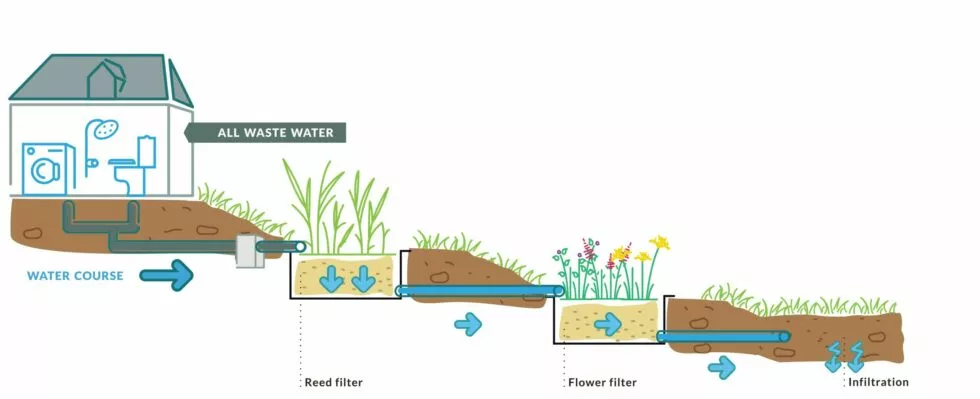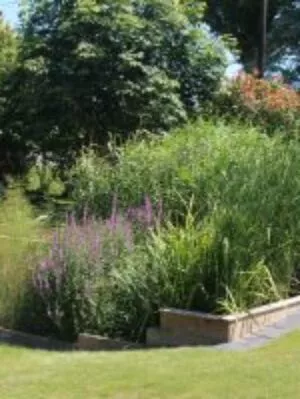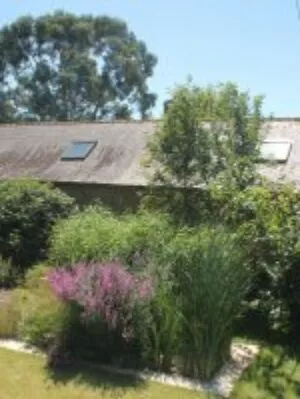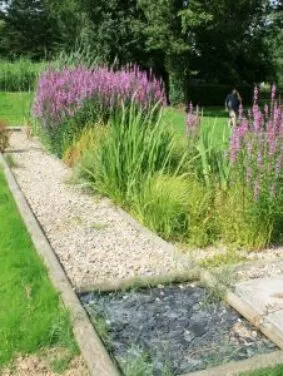Iris Sanitation Garden
Is your individual sanitation system no longer up to standard and you need to replace it? Are you building a house that is not connected to the mains drainage system? Do you have a project for agricultural or semi-collective sanitation for a holiday cottage, a campsite, etc.?

Sanitation Gardens are an excellent alternative to traditional wastewater disposal systems, as they are much less harmful to the environment. Today, there are many companies specialising in the manufacture of this system. Having been created in 2007, Aquatiris is the benchmark in the field, particularly with the Iris range, which is currently the best sanitation system on the market.
The advantages of Iris Sanitation Gardens
The conventional technique used to dispose of domestic wastewater is emptying by means of a septic tank. However, this method has many disadvantages, not only in economic terms, but also and above all for the environment. Fortunately, thanks to the Sanitation Garden, it is now possible to effectively evacuate wastewater from a home without negatively impacting the environment. This innovative solution is particularly relevant for houses that are not connected to the mains drainage system. It is also relevant for tourist accommodation, grouped housing and agricultural estates. It is a system that uses plant species to ensure the natural drainage of water from a house.
Our Iris range has been recognised as the most reliable and robust sanitation system on the market in France. It adapts to variations in load (second home, holidays, etc.), is decorative, ecological, durable and easy to maintain. It does not require sludge removal or energy consumption. Its running cost is therefore quite low.
“Zero tank · Zero emptying · Zero odour nuisance · Zero mosquitoes”
- Adaptation to variations in load (absence, second home, etc.)
- Very low running costs
- No sludge to be emptied
- No energy consumption or chemical reagents
- Several possible finishes (materials, ornaments, plants, etc.)
- Most robust and reliable system according to the 2017 IRSTEA study (French research laboratory)
- Simple garden-type maintenance
- Landscape integration, biodiversity garden

How the Iris Sanitation Garden works

In order to guarantee the efficient removal of wastewater from your home, we have incorporated a two-stage system into our Iris range of Sanitation Gardens. As a result, before returning to the ground, the water from your various rooms will have to pass through the reed filter and the flower filter.
The reed filter
After passing through the pipes in your home, the wastewater first passes through the reed filter. This device can be installed in a courtyard or in an existing garden. It acts like a sieve. It is mainly made up of plants, specifically reeds. These plants have the particularity of protecting wildlife and adapting to all types of soil. Their ability to decontaminate soil makes them the ideal plant species for the effective treatment of wastewater.
In addition to these plants, the reed filter also consists of a relatively equal proportion of gravel, sand and grit. Soluble materials from your home are digested by the micro-organisms and bacteria found around the roots of the reeds. As for non-soluble materials, they are retained on the surface, where they will also be composted. In order to protect you from odour nuisances, we install our reed filters in the open air. The water is then treated in the presence of oxygen, thus guaranteeing a total absence of odours.
The flower filter
In principle, the wastewater that has passed through the reed filter comes out treated. It can therefore return to the soil. However, it still contains some nutrients that may be useful. We therefore choose to make use of them in a second device: the flower filter. Much more ornamental than the previous one, this filter embellishes your garden with its varied species of flowers. It gives your outdoor space an authentic charm. Apart from its decorative function, the flower filter also participates in the treatment of wastewater. Indeed, after an initial filtration at the first device, it then circulates under the gravel of the second device. It then progresses towards the roots of the various plant species planted there. The irises, purple loosestrife and water mint that we favour for this filter have purification capacities similar to those of reeds.
Thus, the main advantage of our Iris range of Sanitation Gardens is the combination of these two filtration systems. They guarantee optimal results in terms of wastewater treatment. To get an idea of the cost of installing an Iris range Sanitation Garden, you can request a free quote now. At Aquatiris, we support you from start to finish in the realisation of your project, from putting together the file to carrying out the work.




